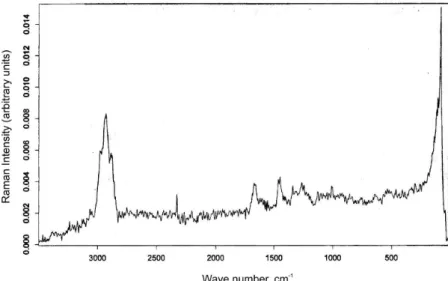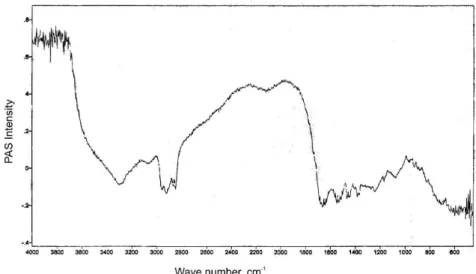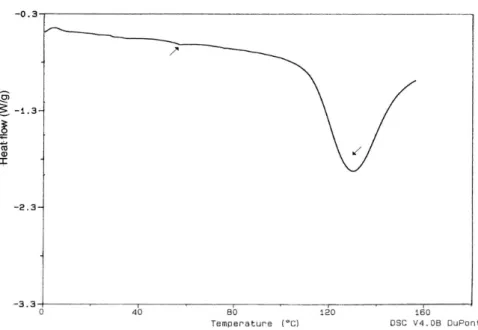*Correspondence: A. R. Baby. Laboratório de Cosmetologia, Departamento de Farmácia, Faculdade de Ciências Farmacêuticas , Universidade de São Paulo, Av. Prof. Lineu Prestes, 580, Bl. 13/15 - Cidade Universitária. 05508-900 - São Paulo - SP, Brasil. E-mail: andrerb@usp.br
A
rti
Pharmaceutical Sciences vol. 45, n. 3, jul./sep., 2009
Spectroscopic and thermal characterization of alternative
model biomembranes from shed skins of
Bothrops jararaca
and
Spilotis pullatus
André Rolim Baby
1, Áurea Cristina Lemos Lacerda
1, Fernanda Daud Sarruf
1, Claudinéia
Aparecida Sales de Oliveira Pinto
1, Vladi Olga Consiglieri
1, Cristina Helena dos Reis Serra
1, Maria
Valéria Robles Velasco
1, Yoshio Kawano
2, Telma Mary Kaneko
11Department of Pharmacy, Faculty of Pharmaceutical Sciences, University of São Paulo 2Department of Fundamental Chemistry, Institute of Chemistry, University of São Paulo
Recently, there has been an interest in the use of shed snake skin as alternative model biomembrane for human stratum corneum. This research work presented as objective the qualitative characterization of alternative model biomembranes from Bothrops jararaca and Spilotis pullatus by FT-Raman, PAS-FTIR and DSC. The employed biophysical techniques permitted the characterization of the biomembranes from shed snake skin of B. jararaca and S. pullatus by the identiication of vibrational frequencies and endothermic transitions that are similar to those of the human stratum corneum.
Uniterms: Biomembrane/alternative models. Bothrops jararaca/skin/qualitative characterization. Spilotis pullatus/skin/qualitative characterization. Human stratum corneum/similars.
Existe atualmente interesse no uso da muda de pele de cobra como modelos alternativos de biomembranas da pele humana. O presente trabalho apresentou como objetivo a caracterização qualitativa de modelos alternativos de biomembranas provenientes de mudas de pele de cobra da Bothrops jararaca e Spilotis pullatus por espectroscopia Raman (FT-Raman), espectroscopia fotoacústica no infravermelho (PAS-FTIR) e calorimetria exploratória diferencial (DSC). As técnicas biofísicas FT-Raman, PAS-FTIR e DSC permitiram caracterizar qualitativamente os modelos alternativos de biomembranas provenientes das mudas de pele de cobra da B. jararaca e S. pullatus e identiicar freqüências vibracionais e transições endotérmicas similares ao estrato córneo humano.
Unitermos: Biomembranas/modelos alternativos. Bothrops jararaca/pele/caracterização qualitativa. Spilotis pullatus/pele/caracterização qualitativa. Estrato córneo humano/similares.
INTRODUCTION
The intact human skin is considered as a barrier against the penetration and permeation of agents such as particles, chemical substances, radiations and microorgan-isms (Williams, Barry, Edwards, 1994). It is of utmost importance for the survival of human beings, despite being an obstacle for the action of active substances applied over the skin (Kalia et al., 2004).
Cutaneous penetration and permeation of active
substances may be irstly limited by the epidermis, espe-cially the stratum corneum (SC), due to its barrier function and to the fact that it is the irst layer of contact with the outer side. The epidermis is divided into two portions: (1)
the internal portion, formed by cells that are constantly proliferating; (2) the external portion, formed by the same cells that originate the SC after its keratinization and death (Moser et al., 2001).
experiment to an Ethics Committee, the storage dificulties and high cost, and the viability of this membrane model limit its usage (Baby et al., 2009; Schmook, Meingassner, Billich, 2001; Rigg, Barry, 1990).
As alternative biomembranes, experimentation ani-mals’ skin, synthetic membranes and three-dimensional cultures are used to experimentally simulate epidermis. There is interest in using shed snake skin in alternative models of human skin biomembranes, and researchers have been evaluating its applicability in penetration / permeation studies, obtaining favorable responses. Shed snake skin is composed by pure SC without viable epidermis and follicles (Rigg, Barry, 1990). It offers a barrier similar to human SC and can be obtained abun-dantly without the death of the animal. Shed snake skin can be easily stored and does not tend to be contaminated nor microbiologically degraded, as it does not present living tissues (Itoh et al., 1990; Baby et al., 2007; Baby
et al., 2008a).
Shed snake skin have similarities with human SC, such as: (1) tissue thickness (human SC = 13-15 μm; shed snake skin = 10–20 μm); (2) protein structure (keratin type α and β); and (3) lipid composition (human SC = 2.0–6.5%; shed snake skin = approximately 6.0%, involving the presence of cholesterol, free fatty acids, glycol ceramides and phospholipids, among others) (Rigg, Barry, 1990).
Various biophysical methods have been employed to study the morphology and dynamics of the SC, aiming to understand the correlation between its structure and func-tion. Among these methods: X-ray diffraction, electron paramagnetic resonance, nuclear magnetic resonance, DSC (Differential Scanning Calorimetry), FT-Raman, and PAS-FTIR (Laleur, 2001; Baby et al., 2006a; Baby
et al., 2008b).
This research work aimed at characterizing qualita-tively alternative models of biomembranes from Bothrops jararaca and Spilotis pullatus shed snake skin through FT-Raman, PAS-FTIR and DSC. It is also worth to mention that the usage of shed snake skin as alternative model of biomembrane to study cutaneous permeation contemplates the aspect of Experimental Ethics in Animals and Human Beings, besides being ecologically correct.
MATERIAL AND METHODS
Sample preparation
Ventral portions of Bothrops jararaca and Spilotis pullatus shed snake skin, gently donated by Butantan Ins-titute, São Paulo, were cut and washed in abundance with
distilled water. The samples were immersed in distilled water for eight hours in order to hydrate. After samples’ hydration, the excess of water was removed with smooth compression using quantitative ilter paper (Baby et al., 2006b). The samples were kept between two microscopy laminas and maintained in a desiccator until the time of analysis with FT-Raman, PAS-FTIR and DSC.
FT-Raman
Raman Bruker® RFS 100/S Spectrometers with
OPUS® software were used. The samples were put in
the analytical compartment and 256 co-additions corre-sponding to the spectra between 3500 and 200 cm-1 were
obtained. The conditions were the following: (1) laser potency: 250 mW; (2) resolution: 4 cm-1; (3)slit: 7; and
(4) gain: 4 (Baby et al., 2007; Baby et al., 2006b). Three replicates were used.
PAS-FTIR
The samples were adequately cut so as to fulill the area of the photoacoustic cell in a model MTEC® 200
spec-trometer. In order to avoid the movement of the cell, the samples were covered by a metal device. Then, a low of helium was used for 2 min to remove water and carbon di-oxide molecules. After sealing the cells, vacuum was made in the spectrometer. The 64 co-additions were controlled using the Bomem® PCDA program, in the spectral range of
4000–400 cm-1. A rubber composite was used as standard.
The experimental conditions were: (1) resolution: 4 cm-1;
(2)slit: 10;(3)gain: 4; and(4) speed of the mobile mir-ror: 0.05 cm/s (Baby et al., 2007; Baby et al., 2006a). The measurements were done using three replicates.
DSC
Samples of approximately 2.0 mg were sealed in a semi-hermetic crucible and were submitted to the follow-ing conditions (Baby et al., 2006b) in the DSC 10 equip-ment: (1)initial temperature: 25.0 °C;(2)cooling ramp: 20.0 °C/min to 0 °C(3) isotherm: 5 min(4) heating ramp: 10.0 °C/min to 160 °C(5) cooling ramp: 20.0 °C/min to 0 °C(6 ) isotherm: 5 min(7)heating ramp: 10.0 °C/min to 160 °C; and (8) inal temperature: 25.0 °C (Baby et al., 2006b).
RESULTS AND DISCUSSION
FT-Raman spectroscopy is useful to study biologi-cal materials, as water presents minimum interference, when compared, for instance, to infrared spectroscopy (Anigbogu et al., 1995; Casper et al., 2001). In the SC study, the vibrational frequencies of particular interest are: C-H (3100–2700 cm-1), C=O (around 1650 cm-1 - amide I)
originated from the α-keratin, C-N (1274 cm-1) and N-H
angular deformation of protein (amide III) (Anigbogu et al., 1995; Baby et al., 2008b; Diem, 1993).
Raman spectra of the SC samples of Bothrops jara-raca and Spilotis pullatus shed snake skin (Figures 1 and 2, respectively) presented spectral proiles similar to the ones described in the literature (Williams, Barry, Edwards, 1994). Characteristic vibrational spectral regions of the SC were observed, with intense signal bands between 3100-2700 cm-1, referring to distensions originated from
the lipid carbonic chains (symmetric and non-symmetric CH3, symmetric and non-symmetric CH2 and CH).
There was a band in the region between 1650-1672 cm-1,
related to the distention of the C=O of the α-keratin’s amide I and, possibly, β-keratin. Besides, there was a band in the region between 1450-1460 cm-1, probably originated from
the angular deformation from C-H to CH, CH2 and CH3. When comparing the Raman spectra from the SC of both species, there are similarities. However, the intensity of the signal appears to be greater for Spilotis pullatus, especially as far as the band between 3100-2700 cm-1 is
concerned, what indicates differences in the biomembrane surface’s morphology among these species.
Raman spectroscopy registers signals due to the spreading light that strikes on the sample’s surface. Therefore, differences in signals’ intensities are related to alterations in the sample’s surface morphology caused by modiications in the molecular density per area unit of the
FIGURE 1 - FT-Raman spectral proile of the Bothrops jararaca biomembrane model.
surface region involved in the spreading of light, and by alterations in its topography (Ingle, Crouch, 1988).
In Figures 3 and 4(PAS-FTIR spectra), we can ob-serve the typical proiles of the hydrated biological mate-rial, with bands in 1650 cm-1 (C=O distension of amide I)
and in 1550 cm-1 (C-N distension and N-H deformation
of amide II). In the band between 3600-3300 cm-1, we can
observe the presence of water in the species’ SC (Golden
et al., 1986; Lin et al., 1992).
The usage of DSC enables the study of structure and organization of the SC though the observation of the char-acteristic temperatures of the endothermic events related to the lipid fraction, e.g. phase transitions, and to the protein fraction of biomembranes that involve dehydration and keratin denaturation phenomena (Lin, Duan, Lin, 1996).
The isolated human SC has four characteristic endo-thermic transitions. The phase transition of the lipid bilayer
from crystalline to gel state is attributed to the temperature of 40 °C. The phase transition of the lipid bilayer from lamellar gel to liquid state is attributed to the temperature of 75-85 °C. The transition that occurs at 105 °C represents the dehydration and denaturation of the protein fraction of the SC and the presence of a certain amount of water in the sample is required for its detection by the technique (Baby et al., 2006b; Golden et al., 1986, Ashton et al., 1992; Leopold, Lipppold, 1995).
In the DSC curve from Bothrops jararaca shed skin (Figure 5), not all the lipids endothermic transition peaks were observed. However, a transition of small magnitude was observed at, approximately, 58 °C. The endothermic peak referring to the transition involving dehydration and keratin denaturation occurred clearly at 130 °C.
Spilotis pullatus shed skin biomembrane presented a DSC curve similar to B. jararaca. The endothermic
transi-FIGURE 3 - PAS-FTIR spectral proile of the Bothrops jararaca biomembrane model.
tions related to lipids were of reduced intensity, observed at 38 and at 58 °C. The transition related to dehydration and denaturation of the protein fraction occurred at 129 °C.
CONCLUSIONS
The biophysical techniques FT-Raman, PAS-FTIR and DSC allowed the qualitative characterization of bio-membranes alternative models from Bothrops jararaca
and Spilotis pullatus shed snake skin, and the identiication of the vibrational frequencies and endothermic transitions similar to those of the human SC.
ACKNOWLEDGEMENTS
The authors would like to thank CAPES, Butantan Institute, especially Dr. Wilson Fernandes and Dr. Otávio Azevedo Mercadante, and the dedicated reviewers of this research work.
REFERENCES
ANIGBOGU, A.N.C.; WILLIAMS, A.C.; BARRY, B.W.; EDWARDS, H.G.M. Fourier transform Raman spectroscopy of interactions between the penetration enhancer dimethyl
sulfoxide and human stratum corneum. Int. J. Pharm.,
Amsterdam, v.125, n.2, p.265-282, 1995.
ASHTON, P.; WALTERS, K.A.; BRIAN, K.R.; HADGRAFT, J. Surfactant effects in percutaneous absorption I. effects
on transdermal flux of methyl nicotinate. Int. J. Pharm.,
Amsterdam, v.87, n.1-3, p.261-264, 1992.
FIGURE 5 - DSC curve of the Bothrops jararaca biomembrane model.
BABY, A.R.; HAROUTIOUNIAN-FILHO, C.A.; SARRUF, F.D.; PINTO, C.A.S.O.; KANEKO, T.M.; VELASCO, M.V.R. Inluence of urea, isopropanol, and propylene glycol rutin in vitro release from cosmetic semisolid systems estimated by
factorial design. Drug Dev. Ind. Pharm., New York, v.35, n.3,
p.272-282, 2009.
BABY, A.R.; HAROUTIOUNIAN-FILHO, C.A.; SARRUF, F.D.; TAVANTE-JÚNIOR, C.R.; PINTO, C.A.S.O.; ZAGUE, V.; ARÊAS, E.P.G.; KANEKO, T.M.; VELASCO, M.V.R. Estabilidade e estudo de penetração cutânea in vitro da rutina veiculada em uma emulsão cosmética através de um modelo de
biomembrane alternativo. Rev. Bras. Cienc. Farm., São Paulo,
v.44, n.2, p.233-248, 2008a.
BABY, A.R.; LACERDA, A.C.L.; KAWANO, Y.; VELASCO, M.V.R.; KANEKO, T.M. PAS-FTIR and FT-Raman qualitative characterization of sodium dodecyl sulfate interaction with an
alternative stratum corneum model membrane. Pharmazie,
Eschborn, v.62, n.10, p.727-731, 2007.
BABY, A.R.; LACERDA, A.C.L.; KAWANO, Y.; VELASCO, M.V.R.; LOPES, P.S.; KANEKO, T.M. Spectroscopic studies
of stratum corneum model membrane from Bothrops jararaca
treated with cationic surfactant. Colloid. Surf. B Biointerfaces, Amsterdam, v.50, n.1, p.61-65, 2006a.
BABY, A.R.; LACERDA, A.C.L.; KAWANO, Y.; VELASCO, M.V.R.; LOPES, P.S.; KANEKO, T.M. Evaluation of the interaction of surfactants with stratum corneum model
membrane from Bothrops jararaca by DSC. Int. J. Pharm.,
BABY, A.R.; LACERDA, A.C.L.; PINTO, C.A.S.O.; LOPES, P.S.; VELASCO, M.V.R.; KANEKO, T.M. Métodos biofísicos
empregados na análise do estrato córneo. Lat. Am. J. Pharm.,
Buenos Aires, v.27, n.1, p.124-130, 2008b.
CASPER, P.; LUCASSEN, G.W.; CARTER, E.A.; BRUINING, E.A.H.; PUPPEL, G.J. In vivo confocal Raman microspectroscopy of skin: noninvasive determination
of molecular concentration profiles. J. Invest Dermatol.,
Baltimore, v.116, n.3, p.434-442, 2001.
DIEM, M. Biophysical applications of vibrational spectroscopy .
In: ___. Introduction to modern vibrational spectroscopy. New
York: John Wiley & Sons, 1993. cap.8, p.205-235.
GOLDEN, G.M.; GUZEK, D.B.; HARRIS, R.R.; MCKIE, J.E.;
POTTS, R. Lipid thermotropic transitions in human stratum
corneum. J. Invest. Dermatol., Baltimore, v.86, n.3, p.255-259, 1986.
INGLE, J.D; CROUCH, S. Spectrochemical techniques on the
horizon. In:___ Spectrochemical Analysis. New Jersey:
Prentice Hall, 1988. cap.17, p.525-541.
ITOH, T.; XIA, J.; MAGAVI, R.; NISHIHATA, T.; RYTTING,
J.H. Use of shed snake skin as a model membrane for in vitro
percutaneous penetration studies: comparison with human
skin. Pharm. Res., New York, v.7, n.10, p.1042-1047, 1990.
KALIA, Y.N.; NAIK, A.; GARRISON, J.; GUY, R.H. Iontophoretic
Drug Delivery. Adv. Drug Deliv. Rev., Amsterdam, v.56, n.5,
p.619-658, 2004.
LEOPOLD, C.S.; LIPPPOLD, B.C. An attempt to clarify the mechanism of the penetration enhancing effects of lipophilic
vehicles with differential scanning calorimetry (DSC). J.
Pharm. Pharmacol., London, v.47, n.4, p.276-281, 1995.
LIN, S. Y.; HOU, S.J.; HSU, T.H.S.; YEH, F.L. Comparisons of different animal skins with human skin in drug percutaneous
penetration studies. Methods Find. Exp. Clin. Pharmacol.,
Barcelona, v.14, n.8, p.645-654, 1992.
LIN, S.Y.; DUAN, K.J.; LIN, T.C. Microscopic FT-IR/DSC system used to simultaneously investigate the conversion process of protein structure in porcine stratum corneum after pretreatment
with skin penetration enhancers. Methods Find. Exp. Clin.
Pharmacol., Barcelona, v.18, n.3, p.175-181, 1996.
MOSER, K.; KRIWET, K.; NAIK, A.; KALIA, Y. N.; GUY, R.H. Passive skin penetration enhancement and its quantiication
in vitro. Eur. J. Phar. Biopharm., Amsterdam, v.52, n.2, p.103 - 112, 2001.
PERCOT, A.; LAFLEUR, M. Direct observation of domains in model stratum corneum lipid mixtures by Raman
microspectroscopy. Biophys. J., New York, v.81, n.4,
p.2144-2153, 2001.
RIGG, P.C.; BARRY, B.W. Shed snake skin and hairless mouse skin as a model membrane for human skin during permeation studies. J. Invest. Dermatol., Baltimore, v.94, n.2, p.235-240, 1990.
SCHMOOK, F.P.; MEINGASSNER, J.G.; BILLICH, A. Comparison of human skin or epidermis models with human
and animal skin in in-vitro percutaneous absorption. Int. J.
Pharm., Amsterdam, v.215, n.1/2, p.51-56, 2001.
WILLIAMS, A.C.; BARRY, B.W.; EDWARDS, H.G.M. Comparison of Fourier Transform Raman spectra of
mammalian and reptilian skin. Analyst, Cambridge, v.119,
n.4, p.563-566, 1994.
Received for publication on 20th February 2008


